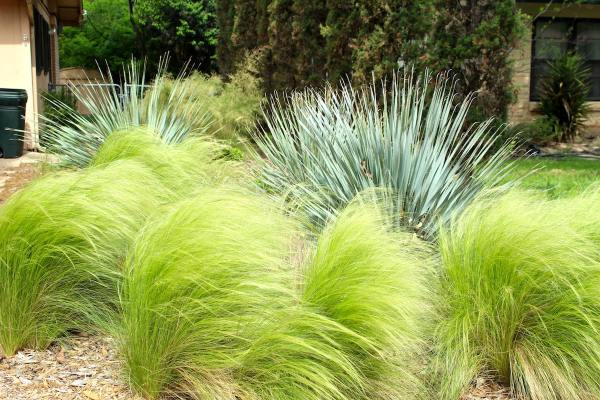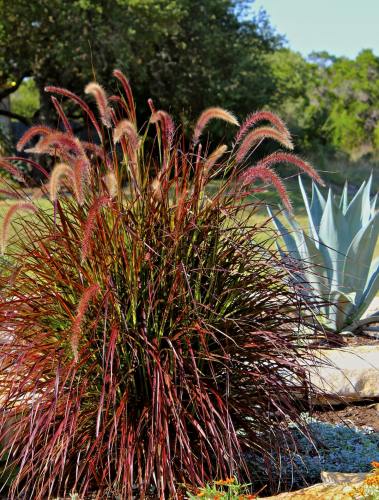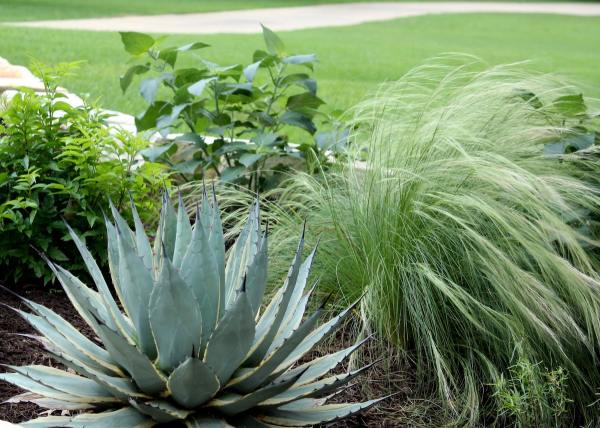You can’t help but stare at them — those delicate grasses now in full bloom, swaying in the breeze all around town. Fall brings beautiful plumes and seed heads to the native and adapted ornamental grasses in Central Texas.
As we face drier and hotter conditions in the garden, ornamental grasses make a wonderful alternative to some thirsty perennials and annuals. They are extremely versatile. Most varieties are hardy, drought-tolerant, pest free and low-maintenance. They range from a few inches high to more than 6 feet tall.
Their tiny flowers on long plumes are called inflorescence and their colors run the gamut from greens, golds and browns to pinks and maroons. The decorative plumage and seedpods can be dried for decorative use in arrangements inside or outside.
Grasses look wonderful in the garden mixed in with perennials to add contrast and texture. But there is nothing quite as bold as a mass planting of grasses to make a statement in the landscape. A long strip of Mexican feather grasses flowing in the wind can emulate a rushing stream – bringing life and movement into the garden.
Most grasses grow in the warm season and are dormant into the winter, but some hold onto their seed heads long into the winter, making for interesting structure and form in the garden and providing both food and habitat for birds.
Technically speaking, some of the plants we call ornamental grasses are actually rushes or sedges and even cattails. Real grasses are in the Gramineae family.
When the Europeans began to settle in Texas, about two-thirds of the land was covered with our native grasses. According to the Texas State Historical Association, grasses ranged from the desert mountains and foothills of the Trans-Pecos to the Rolling Plains and the Edwards Plateau. There are more than 470 native grass species in Texas.
Grasses grow and reproduce in two ways. Some spread by underground rhizomes or as a bunch grass, which does not spread underground. Some seeds sprout easily, growing volunteers where the wind has dropped the seed.
Cool season or fall-blooming grasses should be left through the winter after they are done blooming and go dormant. Keeping the foliage will help protect the plant from a cold or wet winter, reducing the chance of rot. Grasses couldn’t be lower maintenance – just cut them all the way back in the spring and they will reward you with new growth and beautiful blooms year after year. You can shear them down to between 4 and 6 inches above the ground to allow new growth to come through.
As grasses go dormant in the summer, so you may have to rake or pull out some dead foliage mid-summer to keep them looking good. With our long growing season, they will revive with cooler fall temperatures and put on a beautiful show.
Good Grasses for Central Texas
Ruby Crystals – The puffy pink flowers of Ruby grass can grow to 2 ft. by 15” and are stunning in fall bloom.
Mexican Feather Grass – These perky little plants grow to about 18” by 18” and just keep on performing in the garden. It self sows prolifically, but is easily managed.
Gulf Muhly – The glowing pink hue of these blooms is stunning when massed in the garden. This bunch grass grows to about 2.5 ft. by 3 ft.
Lindheimer’s Muhly – Tall creamy plumes of this bunch grass turn to silver in winter and provide striking structure in the winter garden at 2 to 4 ft. tall.
Bamboo Muhly — With an unusual tall and weeping growth habit of 4-5 ft., this muhly has an airy, ephemeral look, instead of the straighter growth habits of most grasses.
Little Bluestem – This is a true prairie bunch grass and can survive in many different soils. Its very upright 3ft by 1.5 ft. growth habit has a wild look and works best in a meadow.
Purple Fountain Grass – The maroon color of the foliage of purple fountain grass, topped by its buff colored plumes, is striking in any setting. Growing up to 3 ft. tall, it demands a place to shine in the garden.
Dwarf fountain grass – Fluffy cream-colored plumes arch above a short clump of delicate green foliage that turns golden in the fall. At about 2 ft. by 2 ft. it’s a compact bundle of pretty form in the garden.
Switchgrass – Tall, airy switchgrass with its blue-colored plumes can grow between 3-8 ft. tall. The plumes turn to a bright orange color in fall.
Maidengrass – One of the most common grasses, maidengrass has a narrow, arching foliage and many variegated options are available, creating even more interest. Leave space for this one – it can grow to 8 ft. tall.
Inland sea oats – This grass has a weeping style with drooping branches of seeds up to 8” long. Inland sea oats requires shade and more moisture than many other grasses. It grows to 2-3 ft. and is a great grass for dried arrangements.
Grasses are an easy, drought-tolerant addition to the garden. They are an excellent low-maintenance option for your landscape, and typically only require cutting back once as year when new growth begins in the spring.
Their billowy plumes and interesting array of colors will add structure, form and movement to your landscape.
With minimal care, they will reward you with new growth and beautiful blooms year after year.

